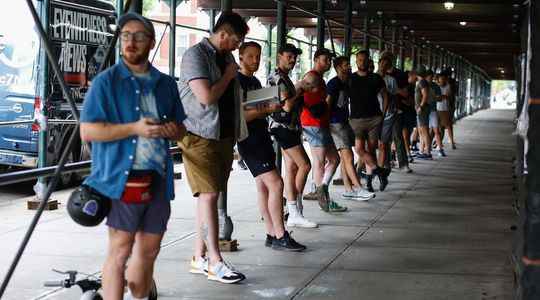The ad has something to remind our memory of bad memories. This Saturday, July 23, and while the Covid-19 epidemic is still not over, the Director General of the World Health Organization (WHO) announced that it was triggering the highest level of alert to deal with the surge in monkeypox cases. The disease has already affected nearly 17,000 people in 74 countries.
Across the Atlantic, while nearly 3,000 Americans have already been infected with this virus, usually more present on the African continent, the city of New York is facing an outbreak of cases. As of July 25, 1,040 people have tested positive there. “There are probably many more cases that have not been diagnosed,” warns the New York State Health Department, on its website.
First case May 19
Officially, the first case of monkeypox in New York dates back to May 19. First treated for a sexually transmitted infection in mid-May, the city’s first patient eventually tested positive for monkeypox, also known as Orthopoxvirus. The “Big Apple” remains a few days with a single patient affected by this epidemic, which at the same time is spreading in Canada but also in France, the United Kingdom and Spain.
Until June 20, the number of daily cases does not exceed ten. But fifteen days later, on July 7, 56 positive tests were carried out. While on July 12, the city recorded 65 infected people. Highest number of cases detected in one day so far, according to the New York State Health Department.
Queues for vaccination
Since then, the largest city in the United States, which has between 8 and 9 million inhabitants, has made many vaccination slots available. But the health services had to apologize on several occasions after numerous failures on the website dedicated to reservations. “Overwhelmed by traffic”, while 1250 appointment slots were available, the site crashed more than once.
On July 15, 9,200 slots had been released by 6 p.m., reports AFP. They left in seven minutes. In recent days, it was not uncommon to see long queues in front of vaccination centers.
In question, according to many associations for the defense of LGBTQI + rights, the lack of vaccines attributed to the city. “Manhattan is the epicenter of the epidemic, but the city has not had its fair share of vaccines. We have had 30% of infections, but only 10% of doses,” laments Jason Cianciotto, vice president of the association for the fight against AIDS GMHC, with our colleagues from World.
Nearly 21,500 doses have already been administered. “But the vaccine supply remains low. NYC is receiving a limited number of doses from the federal government and we are making them available to New Yorkers as quickly as possible,” the state health department reports on its website.
No sick leave in case of infection
On the other hand, contrary to the protocol which had been put in place at the height of the Covid-19 epidemic, the federal State does not this time cover sick leave. And medical consultations remain chargeable.
The White House said this Sunday, July 25, that the monkeypox epidemic could be “eliminated” from the United States thanks to a greater number of vaccines and screening tests available. “The plan is to eliminate the virus from the United States. We can do that,” White House coronavirus response coordinator Ashish Jha said in a televised broadcast. “We acted quickly,” he said, responding to criticism that health authorities reacted too late since the first cases in May in New York.
